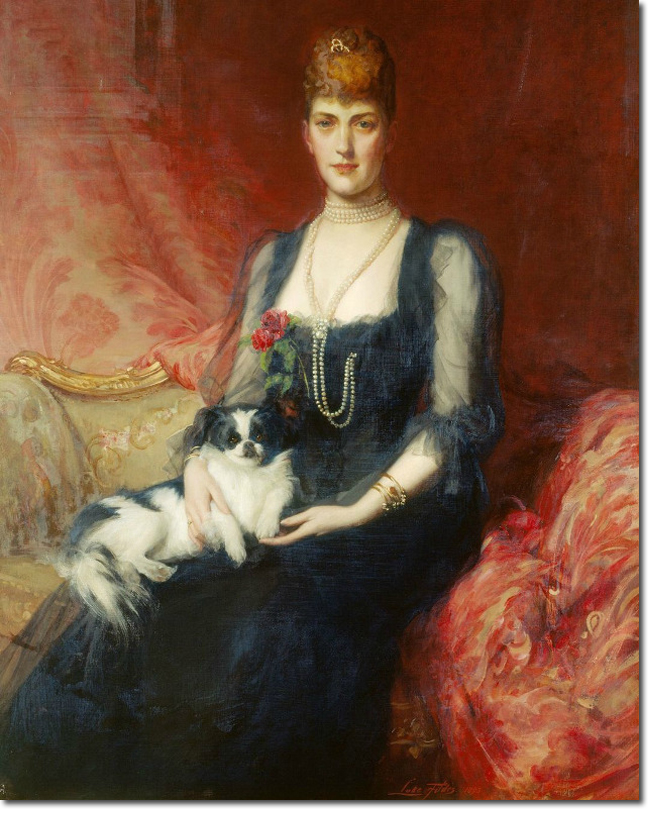|
|


|
|
Alexandra was born on 1 Dec 1844 at the Yellow Palace in Copenhagen. Her full name was Alexandra Caroline Louise Julia. Her father was Prince Christian of Schleswig-Holstein-Sonderburg-Glucksburg, and her mother was Princess Louise of Hesse-Kassel. Her childhood was not as privileged as most royals; they were not rich but the children did have the good fortune to have Hans Christian Anderson call on them occasionally to tell them bedtime stories. There was an improvement in the family status when the problem of the Danish Succession was cleared up. Her father was chosen to succeed the childless King Frederick and they were moved from their relatively modest home into Bernstorff Palace. She and her sisters still had to act as servants at mealtime and make their own clothes.
At the age of 16 she was introduced to the Prince of Wales, Albert Edward at Speyer in Germany. They were engaged a year later on 9 Sep 1862. She sailed to England and landed at Gravesend on 7 Mar 1863. The wedding was 3 days later on 10 Mar 1863 at St George’s Chapel, Windsor. In 1864 her father became King Christian IX of Denmark. It was a turbulent time for her country as Prussia invaded Denmark and seized a large slice of the country. There was division in the royal family owing to the Prince and Princess of Wales supporting Denmark, and Queen Victoria supporting the Germans. Alexandra retained her hatred of all things German after that. Alexandra had six children. She proved to be a caring mother, not shy of rolling up her sleeves and bathing them and looking after them herself. Her third birth brought on a bout of rheumatic fever which left her with a permanent limp. But she enjoyed physical activity; hunting, dancing and ice-skating. She always looked youthful and slim and was regarded as a fashion icon.The couple lived at Sandringham in Norfolk and Marlborough House in London. She tolerated her husband’s infidelities but remained faithful herself. She suffered from deafness which made her more withdrawn from society. Her sixth and final pregnancy ended tragically with the infant dying a day later. The 19th Regiment of Foot invited Alexandra to give her name to the regiment and she consented. In a ceremony on 17 Aug 1875, at Sheffield, she presented new Colours to the 1st Battalion. The title of the regiment was altered to 19th (1st Yorkshire North Riding, Princess of Wales’s Own) Regiment. The 19 was dropped in 1881 and the name Alexandra was added in 1902 after she had became Queen. She was not actually designated as Colonel-in-Chief of the regiment until 1914. In 1892 the Waleses were dealt a terrible blow when their eldest son Prince Albert Victor died of pneumonia following influenza in the pandemic of 1889-92. Two years later she had to provide constant support to her sister who was widowed after Tsar Alexander III died. In 1917 when Tsar Nicholas was killed, her sister managed to escape Communist Russia in 1919. In 1901, with the death of Queen Victoria, she became Queen Alexandra. The Green Howards continued to be named Princess of Wales’s Own. Queen Alexandra was denied any opportunity to become involved in politics or foreign affairs. Her hatred of the Germans prompted her to write a memo opposing the exchange of Heligoland for Zanzibar. She warned that Germany would use Heligoland for strategic purposes against Britain. She was ignored and her prediction came true. As early as 1900 she referred to Kaiser Wilhelm as ‘our enemy’. When King Edward VII died in 1910 she moved out of Buckingham Palace, back to Marlborough House. She still retained Sandringham. As Queen Mother she devoted herself to charitable causes like Alexandra Rose Day where people with disabilities made artificial roses to be sold in aid of hospitals. She suffered ill health towards the end of her life and when a blood vessel burst in her eye she became partially sighted. Her memory and speech were also impaired. She died on 20 Nov 1925 at Sandringham after a heart attack. She is buried in a tomb with King Edward in St George’s Chapel. There is very fine art deco memorial by Alfred Gilbert opposite St James’s Palace. Alexandra Palace near Muswell Hill is named after her as well as many roads. |
Regimental Details | Colonels-in-Chief
Armed Forces | Art and Culture | Articles | Biographies | Colonies | Discussion | Glossary | Home | Library | Links | Map Room | Sources and Media | Science and Technology | Search | Student Zone | Timelines | TV & Film | Wargames